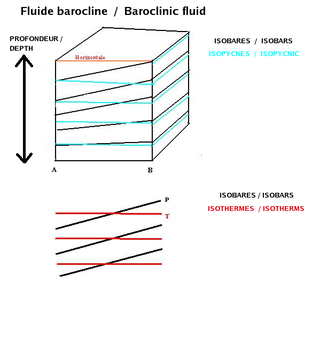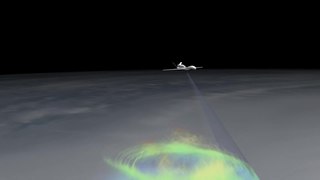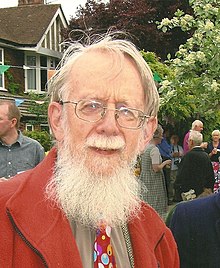Keith Peter Shine FRS is the Regius Professor of Meteorology and Climate Science at the University of Reading. He is the first holder of this post, which was awarded to the university by Queen Elizabeth II to mark her Diamond Jubilee.

The tropopause is the atmospheric boundary that demarcates the troposphere from the stratosphere, which are the lowest two of the five layers of the atmosphere of Earth. The tropopause is a thermodynamic gradient-stratification layer that marks the end of the troposphere, and is approximately 17 kilometres (11 mi) above the equatorial regions, and approximately 9 kilometres (5.6 mi) above the polar regions.

In fluid dynamics, the baroclinity of a stratified fluid is a measure of how misaligned the gradient of pressure is from the gradient of density in a fluid. In meteorology a baroclinic flow is one in which the density depends on both temperature and pressure. A simpler case, barotropic flow, allows for density dependence only on pressure, so that the curl of the pressure-gradient force vanishes.
Rossby waves, also known as planetary waves, are a type of inertial wave naturally occurring in rotating fluids. They were first identified by Sweden-born American meteorologist Carl-Gustaf Arvid Rossby in the Earth's atmosphere in 1939. They are observed in the atmospheres and oceans of Earth and other planets, owing to the rotation of Earth or of the planet involved. Atmospheric Rossby waves on Earth are giant meanders in high-altitude winds that have a major influence on weather. These waves are associated with pressure systems and the jet stream. Oceanic Rossby waves move along the thermocline: the boundary between the warm upper layer and the cold deeper part of the ocean.
Professor Sir Brian John Hoskins, CBE FRS, is a British dynamical meteorologist and climatologist based at the Imperial College London and the University of Reading. He is a recipient of the 2024 Japan Prize along with Professor John Michael Wallace in the field of "Resources, Energy, the Environment, and Social Infrastructure" for "Establishment of a scientific foundation for understanding and predicting extreme weather events". He is a mathematician by training, his research has focused on understanding atmospheric motion from the scale of fronts to that of the Earth, using a range of theoretical and numerical models. He is perhaps best known for his work on the mathematical theory of extratropical cyclones and frontogenesis, particularly through the use of potential vorticity. He has also produced research across many areas of meteorology, including the Indian monsoon and global warming, recently contributing to the Stern review and the IPCC Fourth Assessment Report.

A hot tower is a tropical cumulonimbus cloud that reaches out of the lowest layer of the atmosphere, the troposphere, and into the stratosphere. These formations are called "hot" because of the large amount of latent heat released as water vapor condenses into liquid and freezes into ice within the cloud. Hot towers in regions of sufficient vorticity may acquire rotating updrafts; these are known as vortical hot towers In some instances, hot towers appear to develop characteristics of a supercell, with deep and persistent rotation present in the updraft. The role of hot towers in tropical weather was first formulated by Joanne Simpson in 1958. Hot towers dominated discussions in tropical meteorology in the 1960s and are now considered the main drivers of rising air within tropical cyclones and a major component of the Hadley circulation. Although the prevalence of hot towers in scientific literature decreased in the 1970s, hot towers remain an active area of research. The presence of hot towers in tropical cyclones is correlated with an increase in the tropical cyclones' intensities.
In fluid mechanics, potential vorticity (PV) is a quantity which is proportional to the dot product of vorticity and stratification. This quantity, following a parcel of air or water, can only be changed by diabatic or frictional processes. It is a useful concept for understanding the generation of vorticity in cyclogenesis, especially along the polar front, and in analyzing flow in the ocean.

Syukuro "Suki" Manabe is a Japanese–American physicist, meteorologist, and climatologist, who pioneered the use of computers to simulate global climate change and natural climate variations. He was awarded the 2021 Nobel Prize in Physics jointly with Klaus Hasselmann and Giorgio Parisi, for his contributions to the physical modeling of Earth's climate, quantifying its variability, and predictions of climate change.
In differential geometry, the equivalent latitude is a Lagrangian coordinate . It is often used in atmospheric science, particularly in the study of stratospheric dynamics. Each isoline in a map of equivalent latitude follows the flow velocity and encloses the same area as the latitude line of equivalent value, hence "equivalent latitude." Equivalent latitude is calculated from potential vorticity, from passive tracer simulations and from actual measurements of atmospheric tracers such as ozone.
The Held–Hou Model is a model for the Hadley circulation of the atmosphere that would exist in the absence of atmospheric turbulence. The model was developed by Isaac Held and Arthur Hou in 1980.
Peter Howard Haynes is a British applied mathematician in the Faculty of Mathematics at the University of Cambridge. He is a Fellow of Queens' College, Cambridge and served as Head of the Department of Applied Mathematics and Theoretical Physics (DAMTP) from 2005 to 2015.

Theodore Gordon Shepherd is the Grantham Professor of Climate Science at the University of Reading.
Michael Ghil is an American and European mathematician and physicist, focusing on the climate sciences and their interdisciplinary aspects. He is a founder of theoretical climate dynamics, as well as of advanced data assimilation methodology. He has systematically applied dynamical systems theory to planetary-scale flows, both atmospheric and oceanic. Ghil has used these methods to proceed from simple flows with high temporal regularity and spatial symmetry to the observed flows, with their complex behavior in space and time. His studies of climate variability on many time scales have used a full hierarchy of models, from the simplest ‘toy’ models all the way to atmospheric, oceanic and coupled general circulation models. Recently, Ghil has also worked on modeling and data analysis in population dynamics, macroeconomics, and the climate–economy–biosphere system.

Graeme Leslie Stephens is director of the center for climate sciences at the NASA Jet Propulsion Laboratory at the California Institute of Technology and professor of earth observation the University of Reading.
Dave Fultz was an American professor of meteorology, known for his research on atmospheric air movements and hydrodynamics.
M. Joan Alexander is an atmospheric scientist known for her research on gravity waves and their role in atmospheric circulation.
Bette Otto-Bliesner is an earth scientist known for her modeling of Earth's past climate and its changes over different geological eras.
Marcia Baker is a retired professor known for her research on cloud physics which informs global climate models and defines the processes leading to the formation of lightning from clouds.
Sukyoung Lee is a professor at Pennsylvania State University known for her research on circulation in Earth's atmosphere and the Southern Ocean. In 2021 Lee was elected a fellow of the American Geophysical Union.
Kerry Harrison Cook is an American climate scientist who is a professor at the University of Texas at Austin. Her research focuses on the analysis of climate variability and change in the tropics using observational analysis and high-resolution numerical modeling. Specialties include the climate of Africa and the dynamics of intense tropical rainfall. She was elected Fellow of the American Meteorological Society in 2009 and was awarded the Joanne Simpson Tropical Meteorology Research Award in 2021. She is the Chair of the American Meteorological Society's Climate Variability and Change Committee.






